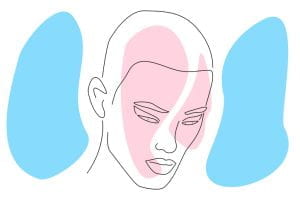March 31, 2022 | Kimberly Randall, Lister Hill Center for Health Policy

Background:
Since their inception, United States government documents have only allowed two options for gender selection: male or female. The modern understanding of gender identity has shifted to view gender as a spectrum, rather than a dichotomy. Research has differentiated between biological sex and gender identity, which has opened up conversations regarding gender-inclusive language on a variety of platforms in recent years.
The idea of including a third gender option on government identification has already been taken up by several state agencies. According to the National Center for Transgender Equality, 22 US states currently allow for a third gender option on a driver’s license or state-issued photo identification, while 16 states allow for the option on a birth certificate. In almost all cases, the third-gender option is marked with an X.
In 2020, legislation was filed in the US House of Representatives calling for a third-gender option on passports, and the following year, the first passport with an X gender marker was printed. However, its recipient, Dana Zzyym, underwent extensive legal and medical scrutiny to demonstrate that they were neither male or female but intersex, and represented themselves as non-binary. The process for obtaining a third-gender passport in the US was seen as expensive and lengthy, requiring extensive documentation, prior to recent changes.
Denmark became the first nation to allow for a third-gender option on official documentation in 2014, with Malta following suit in 2016. To date, fifteen countries officially allow for third-gender options on government documents.
Policy:
Announced via Twitter on Transgender Day of Visibility, US Secretary of State Anthony Blinken stated “we recognize the achievements and resilience of transgender, nonbinary, and gender non-conforming persons worldwide. … U.S. Citizens will be able to select X as their gender marker on their U.S. passport book starting April 11.”
The official State Department website was updated to reflect the announcement, detailing the process for how citizens can apply for or update their passport under the new guidelines:
“You can select the gender marker you would like printed on your U.S. passport. The gender you select does not need to match the gender on your supporting documentation such as a birth certificate, previous passport, or state ID. We no longer require medical documentation to change the gender marker on your U.S. passport.
Beginning April 11, 2022, you can select male (M), female (F), or unspecified or another gender identity (X) as your gender marker if you are applying for a U.S. passport book and selecting routine service. Beginning in late 2023, you will be able to select X as a marker if you are seeking a passport card or selecting expedited service.”
The policy with initially apply to traditional passport applications utilizing Form DS-11, however the State Department has stated that additional documents including passport cards, emergency passports printed at embassies and consulates, expedited and emergency passports issued at passport agencies, and Consular Reports of Birth Abroad will have the option by late 2023.
Impact:
Recent population studies have shown that up to 4.6% of individuals currently identify as nonbinary or gender nonconforming, while as many as two million US citizens identify as transgender. A study in the Journal of Adolescent Health found a positive correlation to overall mental wellbeing with higher rates of gender affirmation through medical care, educational experiences, and social interactions. Gender-affirming government documents are anticipated to have similar positive impacts on mental health.
The addition of a third-gender option enables individuals to feel gender congruence, or “the feeling of harmony with one’s gender.” Being noted as a gender nonconforming person could help aid in how individuals are seen and recognized in an official capacity. Increased gender congruency has been shown to increase positive outlook regarding one’s identity and overall life satisfaction. In addition, gender-affirming recognition and language are linked to lower rates of anxiety, depression, and suicide in non-binary persons. According to the ILGA, “the X marker could provide relief to non-binary person, persons not identifying with any gender at all and persons currently transitioning.”
While activists have advocated for a third-gender option on official documentation as early as 2000, there are some fears that it could increase discrimination for visa applications and border crossings. Australia, an X-gender issuing nation, has warned that travelers utilizing the third-gender option could face difficulties when entering certain countries. Additionally, logistical issues such as checking in for an airline flight where there is no third gender option may impact travelers as well. It is expected that following the updated passport policy, federal regulations regarding this will change in the coming months.
Next Steps:
The policy for U.S. passports will go into effect on April 11th and the move has received support from President Biden. However, legislation has been passed in the Alabama Senate and is now in debate in the House of Representatives that would restrict access to gender-affirming medical care for citizens under the age of 18. SB184 would prohibit medical procedures or prescriptions intended to alter the physical appearance or hormonal balance of individuals undergoing transition. If you want to make your voice heard on this or future legislation, click here to identify your elected officials.
Don’t know what to say? Check out this guide from the American Civil Liberties Union on drafting a letter to your government officials.
Learn More:
Want to learn more about LGBTQ+ policy initiatives? Check out these resources.
International Lesbian, Gay, Bisexual, Trans, and Intersex Association
